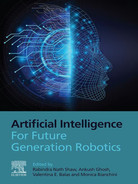Table of Contents
1.7 Conclusions and future work
2.5 Conclusions and future work
3.2 2D CNN—a brief introduction
3.3 1D convolutional neural network
3.4 Statistical parameters for feature extraction
5.4 Elderly people detect depression signs and symptoms
6.2 Data heterogeneity mitigation
6.3 LSTM-based classification of data
6.5 Conclusion and future work
Chapter Seven. Advance machine learning and artificial intelligence applications in service robot
7.3 Uses of artificial intelligence and machine learning in robotics
Chapter Eight. Integrated deep learning for self-driving robotic cars
8.2 Self-driving program model
8.4 Deep reinforcement learning
Chapter Nine. Lyft 3D object detection for autonomous vehicles
Chapter Ten. Recent trends in pedestrian detection for robotic vision using deep learning techniques
10.2 Datasets and artificial intelligence enabled platforms
10.4 Applications of robotic vision toward pedestrian detection
10.5 Major challenges in pedestrian detection
